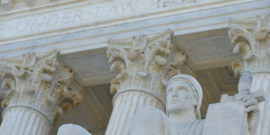Originalism, Conservatives, and the Constitution
In Conservatives and the Constitution: Imaging Constitutional Restoration in the Heyday of American Liberalism, Ken I. Kersch provides a tour de force survey of conservative constitutional theory between World War II and 1980. The book, the first of a planned trilogy, provides as much an intellectual history of American conservatism during this period as it does a conservative constitutional theory. The scope of his discussion impresses. From traditionalists, libertarians, Straussians, religious leaders (Catholic, Evangelical, Jewish and Mormon), to Austrian economists, neoconservatives, public choice and rational choice theorists, all come within the book’s compass.
Kersch argues throughout that liberals—and the liberal professoriate, particularly those in law schools—do not recognize the heterogeneity of conservative constitutional thought prior to the Reagan Revolution of 1980. This lack of recognition results partly from the absence, if not exile, of conservative academics from the ascendant liberalism of the legal academy during the period (until the early 1970s). This lack of recognition also results from the identification today of conservative constitutionalism with “originalism.” Doing so, however, projects backwards an intellectual movement gaining ascendency largely after 1980, even though its roots were planted in the earlier period.
In a book as ambitious and wide ranging as Kersch has written, there are bound to be a few missteps. Some minor, if not almost trivial, others more a matter of perspective, and a few are more serious.
First, in the “matter-of-perspective” category, Kersch makes repeated swipes at the ostensible hegemony of modern originalism. This he pits against “the broader, more philosophical” conservative constitutionalism of the pre-1980s era. The axe grinding, however, struck me as gratuitous.
There is, after all, a difference between constitutional theory and a theory of constitutional interpretation, even as they interrelate. To be sure, one’s constitutional theory cannot help but influence one’s constitutional interpretation in the face of textual ambiguity. Yet originalism is a theory of constitutional interpretation, and as such it is not—nor can it be—a constitutional theory in itself. Indeed, significant differences in constitutional theories divide modern originalists—despite agreement that textual interpretation should be originalist. (Consider the heated discussion among L&L contributors on the Fourteenth Amendment’s privileges and immunities clause some months back.)
Kersch at times writes as if modern originalism is at variance with conservatives during this period who advocated amending the Constitution or who criticized significant aspects of the Constitution. While originalist legal scholars undoubtedly have opinions of what provisions they think should be included or excluded in a constitution, the interpretive project of originalism is to understand the text of the Constitution as it is actually written. As an interpretive methodology, originalism is agnostic as to what should or should not be included in that text. Critics of originalism often conflate focus on understanding original text with worshipping original text. This as opposed to originalism as an interpretive methodology whether one approves of the text or not. The mistake in this gloss is more difficult to make when thinking of originalist approaches to statutory interpretation (a major focus of Justice Scalia’s book on originalism). There, originalist/textualist interpretation of the statutory text can rarely be mistaken as “worship” of the often obscure topics legislated in the interpreted statute. “Constitutions” are just special types of statutes.
Other missteps result from Kersch missing some “inside baseball” stuff, even given the impressive scope of his research. For example, Kersch generally does a superb job of reporting different currents of constitutional theory among religious conservatives—evangelical, fundamentalist, Jewish, Catholic and Mormon. Yet when discussing the views of “fundamentalist, evangelical, and other leading conservative Christian voices” related to constitutionalism, Kersch argues that these Christians share a deep theoretical unity with libertarians because of the Christians’ “foundational understanding of free will” as they understand it to be taught in “the literal Word of God.”
The problem with Kersch’s theoretical gloss here is that top leaders among the evangelicals and the fundamentalists whom Kersch discusses—Carl McIntire, R.J. Rushdoony, Francis Schaeffer—were dyed-in-the wool Calvinists. They believed the Bible did not teach free will, but rather teaches The Bondage of the Will, as Martin Luther titled his famously predestinarian reply to Erasmus in 1525. (Ironically, the book remains more popular among Calvinists today than among Lutherans themselves.)
Less excusable, however, is Kersch’s serious misreading of the argument James Buchanan and Gordon Tullock advance in The Calculus of Consent. The Calculus, as Kersch correctly observes, is “the seminal public choice work that set[s] out expressly constitutional understandings . . .” But Kersch misses the central argument of the book, an argument that is neither inherently conservative nor anti-government.
Kersch presents the argument of The Calculus as if it were “a major assault on the theory . . . that the enactment of laws by popularly elected legislatures . . .represented the apotheosis of democracy.” As such, he writes, the argument in The Calculus implies a heightened role for courts in reviewing legislation because legislation “is, typically, little more than legalized theft.”
Kersch misses the originality of The Calculus, and fails to grasp not only the book’s central argument but also how that argument stands orthogonally to much of Buchanan and Tullock’s subsequent work.
Indeed, the whole point of The Calculus is to lay out a social contract account in which individuals unanimously consent to (legislative) decision-making rules at the constitution-making stage that could nonetheless trench on their interests at the policy-making stages.
Buchanan and Tullock’s argument is their answer to the claim that Kersch incorrectly imputes to The Calculus, that legislation is “little more than legalized theft.”
The basic setup of Buchanan and Tullock’s argument in The Calculus is akin to John Rawls’ framing of his Theory of Justice—and social contract theorists more generally.
In The Calculus, Buchanan and Tullock first set up a constitution-making stage that specifies decision-making rules for legislation at the subsequent policy stages. To do this, they first assume individuals are “uncertain” as to what their “precise role[s] will be in any one of the whole chain of later collective choices that will actually have to be made.” About these representative individuals behind what Rawls would later famously term a veil of ignorance, they write:
For this reason he is considered not to have a particular and distinguishable interest separate and apart from his fellows. This is not to suggest that he will act contrary to his own interest; but the individual will not find it advantageous to vote for rules that may promote sectional, class, or group interests because, by presupposition, he is unable to predict the role that he will be playing in the actual collective decision-making process at any particular time in the future. He cannot predict with any degree of certainty whether he is more likely to be in a winning or a losing coalition on any specific issue.
What is being decided at the constitution-making stage is the society’s decision-making rules. Critically for Buchanan and Tullock, their individuals recognize that they do not want a society in which collective decisions—government decisions—are made only if there is unanimous consent. A unanimity rule prevents too much useful and desired legislation. At the same time, no one wants legislation to be adopted that only one person prefers. That will impose too many costs on everyone else.
The trick for Buchanan and Tullock’s constitution stage is for the individuals behind the veil of ignorance to think of non-unanimous decision rules that allow on average for legislative benefits greater than costs.
The whole point of the exercise is that there would be unanimous consent at the constitution-making stage to agree to a set of non-unanimous decision-making processes for the policy-making stages. The expectation is that there will be any number of pieces of legislation that will impose costs greater than benefits for any number of individuals in the society. But this is an acceptable cost given that other legislation will benefit those individuals.
Thus, Buchanan and Tullock offer an argument justifying non-unanimous legislative power, and not opposing it as Kersch claims.
Some years back, I was at a conference in recognition of the work of Gordon Tullock. Tullock was there as well as Buchanan, along with a host of other notable scholars in public choice. (I frankly wasn’t sure why I was invited.) In a discussion of The Calculus, a scholar stood up and gave a short speech in praise of The Calculus and its role in making the case for limited government. After the panegyric, a young scholar, somewhat timid given the big names in the room, raised his hand and commented that, on his reading, the argument in The Calculus was just as consistent with big government as it was with small government; the size of the government depended entirely on the policy preferences of the individuals in that particular society.
Buchanan leaned over the table, looked at the young scholar, and said simply, “You’re right.”
Now, don’t get me wrong, neither Buchanan nor Tullock was a fan of big government. But their seminal contribution in The Calculus was an argument in favor of government, one that would have individuals recognize that they will win sometimes and will lose sometimes in the legislative process. The upshot was that legislative losses do not by themselves constitute an argument against the legitimacy of a constitutional regime.
Kersch’s fumble on The Calculus is, however, the exception and not the rule. By and large the book is an encyclopedic and sympathetic, if not uncritical, study of conservative constitutionalism. I anticipate the subsequent volumes in the series.



